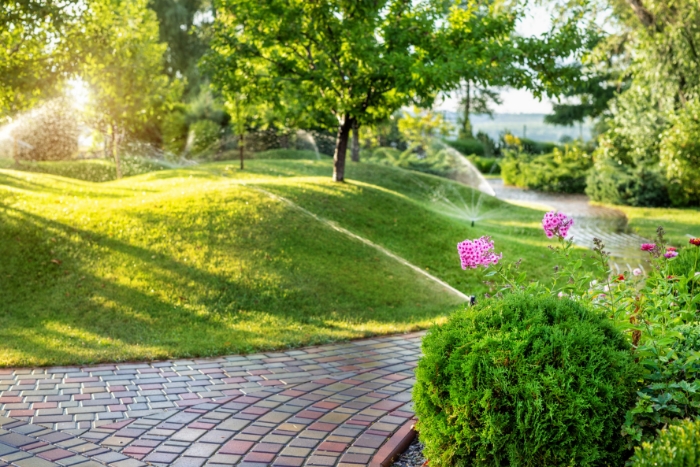Technology advancements are transforming the landscape irrigation industry, making it more efficient, data-driven, and user-friendly. Simultaneously, smart irrigation products are improving water conservation efforts. Most importantly, contractors who use smart irrigation technology are giving customers what they want.
“The customer base has changed,” says Scott Knowles, CGIA, CIC, CID, CLIA, retired CEO of Wolf Creek Co. Inc. and an Irrigation Association University instructor. “We have younger people who are familiar with and want the technology. Before, contractors could be laggards in technology adoption. Not today — if they’re not using smart technology, their business is going to suffer.”
Social media and even major news outlets run stories like The New York Times’ 2024 article “The Best Smart Sprinkler Timer,” advising homeowners on which smart controllers to buy. So, if a consumer asks about advanced irrigation controllers or specific features and you refuse to consider it, chances are they will find another contractor who will, according to Knowles. In some cases, they might skip hiring contractors, buy it online or at the big box store and install it themselves.
 For Nick Millward, CIC, CID, CIT, CLIA, CLWM, vice president of Seattle-based City Rain Inc., smart irrigation products are the company’s default on every job. He acknowledges that there are situations where weather conditions need to be ignored or overridden.
For Nick Millward, CIC, CID, CIT, CLIA, CLWM, vice president of Seattle-based City Rain Inc., smart irrigation products are the company’s default on every job. He acknowledges that there are situations where weather conditions need to be ignored or overridden.
“New plantings may require a grow-in period of watering; certain beds may be under overhangs or sheltered from the weather,” he says. “Pots, hanging baskets and window boxes are tricky to schedule and may be impossible to set up by a weather-based approach.”
It’s no longer a question about when to use smart irrigation technology on job sites, but how you can leverage it in your business. Here, you can learn how contractors use a variety of tools to increase efficiency and profit, meet and exceed customer expectations, and support water conservation.
Wi-Fi and cloud-based management
When Wi-Fi capability first hit the market, Millward worried customers would have too much control and might screw up the programming. However, those concerns have not materialized, and the results have been a game-changer.
“It was disconcerting at first for an old timer like me, but I’m on board now,” he says. “The biggest part of the game-change is service calls. Some trips can be eliminated, while on-site service routines are expedited greatly from the smartphone.”
City Rain’s client base is 99% residential. The company installs Wi-Fi controllers on every property and relies on advanced settings to program accurate application rates based on soil type, microclimate, plant type, slope and other factors.
“The smart settings have been effective with real-time weather conditions, but from time to time, we need to check closely which weather station is reporting the most accurate data,” he says. “Also, having the ability to manually set the application rate is key because default settings for sprinkler type may be way off.”
Most manufacturers provide easy access to weather data when the controller is connected to the internet. Data based on recent weather conditions and, in some cases, future predictions, enables the controller to adjust scheduling to reduce the changes of over or underwatering.
“[Leveraging smart technology] reduces unnecessary watering,” Millward says. “It’s important to remember that ET-based watering can surprisingly increase during heat waves, and if settings aren’t dialed in correctly, this can result in a shocking water bill.”
Knowles adds that contractors leveraging remote, app-based features on controllers report a dramatic improvement in service call efficiencies. Alerts about excessive water flow make it possible to quickly identify broken lines, missing sprinklers or malfunctioning valves, saving service techs hours of on-site troubleshooting. Similarly, alarms identify wiring issues that can help contractors pinpoint affected zones and the type of electrical fault.
“Finding the exact location of wiring issues can still be challenging, but tools exist to locate damaged wires or malfunctioning valves,” Knowles says.
From a customer service standpoint, contractors who use remote-monitoring capabilities can detect a problem before the property owner knows something is wrong. Imagine dramatically reducing (or eliminating) voicemail from upset customers because something in their system isn’t working properly.
“You can call the customer and say, ‘You have a problem on zone four, and we can come out tomorrow and fix it for you,'” Knowles says. “Instead of the customer seeing brown grass or other problems and calling in upset mode, you can take care of it before the customer even knows they’re broken.”
Another benefit of using smart controllers is eliminating some add-on products and related maintenance. “You don’t need a rain sensor,” Knowles says. “Most rain sensors need to be maintained and are only good for a few years.”
Selling commercial property managers and schools on Wi-Fi and remotely monitored products may require extra effort. Many of these sites have internal IT departments and/or strict cybersecurity practices and won’t allow smart irrigation products to connect to the network.
“The workaround is to set up another network using a cell modem,” Knowles says.
AI-driven water management
Most commercial and residential irrigation advancements trickle into the industry from agricultural applications. Farmers and ranchers are embracing artificial intelligence to achieve irrigation accuracy and efficiencies not seen before. Known as precision agriculture, AI is driving decisions on everything from how much fertilizer or seed to apply and disease detection to weather prediction and water applications.
“When you talk to younger folks who are running and taking over the operation of farms, they’re doing business on an iPad or their phone,” Knowles says. “They are adopting the technology much more readily than before; that’s what’s going to make a drastic change over the next five to 10 years. What’s going on with irrigation 10 to 15 years from now will be shocking as AI gets built into products.”
AI is driving decision-making that maximizes efficiency and sustainability in many ways. This is critical in residential and commercial irrigation as municipalities increase water prices or issue watering restrictions. In the irrigation industry, data, machine learning and automation provide insights into:
- How much to water.
- When to water.
- How to water (sprays, drips, emitters, bubblers, etc.).
“I’m open-minded and cautiously optimistic. I have zero experience with it, but I think the GIGO (garbage in, garbage out) principle would apply,” says Millward. “I think you have to start with human intelligence to accurately assess the soil texture, plant types, exposures and precipitation rates in order for AI to take it from there. Like all this technology, I think good outcomes are dependent on human observations and adjustments.”
How to build smart irrigation products into your business
One of the biggest hurdles Knowles sees contractors struggling with related to the adoption of smart irrigation products is pricing. He has heard many contractors say they don’t believe customers will pay for technology-enhanced projects.
But for those willing to rethink their pricing structure and move past the fear of technology, it’s been a game-changer for their business. Internally, bringing smart irrigation tools into the business can increase efficiencies, and externally, it serves a key difference in the market.
“The cost savings I like to sell customers on is our expedited service calls with shared access to Wi-Fi controllers,” Millward says. “For us, the faster we get our service calls done, the cheaper the labor bill. The more service calls we can complete in a day, the more money we make.”
Knowles shares an example of a contractor who embraced smart irrigation technology early, a decade ago. This business owner retooled his entire business around installing and servicing one brand. “That way, his people can be experts on all that comes along with that brand,” he says. “They know the software, the hardware and the glitches.”
If a customer has a different controller, the company’s salespeople explain they only service one brand and offer to replace the existing one. If the customer complains, they compare irrigation controller service to vehicle service.
“He says, ‘If you’re a BMW owner and have service issues, are you going to take it to Johnny’s shop down the street or are you going to take it to a BMW dealer with the trained technicians,'” Knowles says.
Knowles has seen contractors price service contracts based on using smart irrigation technology in different ways. Here, he shares several of the models contractors are using:
- A value-added offering to existing services.
- An annual contract that includes X amount a year for monitoring services.
- A service package for monitoring services, plus a pre-approval for repairs up to an agreed-upon amount if an issue is detected.
“Annual contracts offer a secondary income stream that helps cash with cash flow,” he says.
Embrace the fear
Change — especially the rapid technological changes taking place today — can feel overwhelming. But to remain relevant, irrigation contractors must find ways to leverage the features in smart irrigation products — if not to boost internal efficiencies and overcome labor shortages, then to give customers what they want or risk going out of business.
“Get over the fear. Learn it. Make it a tool to build and maintain your business, or the business won’t be there. That’s all there is to it,” Knowles says. “Many contractors who are doing it have said, ‘We found our way, and we’re not going back.'”





